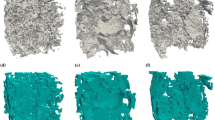Abstract
Experimental data are presented on the effects of water-soluble macromolecular compounds (MMC) on the internal mass transfer in quartz sand and peat under non isothermal conditions.
Similar content being viewed by others
Literature cited
P. A. Rebinder, “Adsorption layers and their effects on the properties of dispersed systems,” in: Surface Phenomena in Dispersed Systems [in Russian], Nauka, Moscow (1978). pp. 196–235.
K. S. Akhmedov, “Simple and macromolecular polyfunctional surface-active substances for controlling the properties of dispersed systems,” in: Physicochemical Principles of Using Surfactants [in Russian], FAN, Tashkent (1977), 21–23.
G. L. Maslenkova, “A study of structure-forming polymers by infrared spectroscopy,” Kolloidn. Zh.,23, No. 5, 615–621 (1961).
I. I. Lishtvan, “A study of the physicochemical nature of peat and of the structuring processes in peat systems, with a view of regulating their properties,” Author's Abstract of Candidate's Dissertation, Technical Sciences, Kalinin Polytechnical Institute (1969).
I. I. Lishtvan, N. V. Churaev, A. A. Terent'ev, and A. M. Abramets, “Use of surfactants and polymers for controlling the internal mass transfer in dispersed systems,” in: Heat and Mass Transfer in Open-Pore Bodies (including drying processes) [in Russian], ITMO Akad. Nauk Bel. SSR, Minsk (1980), pp. 29–34.
A. M. Abramets, “A study of the effects of surfactants and MMC on structuring and mass transport in peat systems,” Author's Abstract of Candidate's Dissertation, Technical Sciences, Minsk (1980).
A. A. Terent'ev, A. M. Abramets, and V. A. Min'kov, “A study of the scope for using polymers to control evaporation from peaty soil,” Abstracts for the Republican Conference on Problems in the Mineralization and Erosion of Peat [in Russian], Nauka i Tekhnika, Minsk (1978), p. 93.
A. M. Abramets, I. I. Lishtvan, and A. A. Terent'ev, “Use of polyelectrolytes to control evaporation in peat soils,” Pochvovedenie, No. 4, 141–144 (1981).
N. I. Gamayunov, “Heat and mass transfer in peat systems,” Author's Abstract of Candidate's Dissertation, Technical Sciences, Kalinin Polytechnical Institute (1967).
P. N. Davidovskii, “A study of the thermal water transfer in peat systems using radio active isotopes,” Author's Abstract of Candidate's Dissertation, Technical Sciences, Minsk (1965).
Surfactants Handbook [in Russian], Khimiya, Leningrad (1979).
A. V. Lykov, Theory of Drying [in Russian], Energiya, Moscow (1968).
A. M. Globus, “A study of the movement of water in soils in response to a temperature gradient,” Author's Abstract of Candidate's Dissertation, Technical Sciences, Leningrad (1962).
B. V. Deryagin, A. P. Ershov, and N. V. Churaev, “Thermoosmotic flow in setting water films on the surfaces of capillaries,” in: Surface Forces in Thin Films and Dispersed Materials [in Russian], Nauka, Moscow (1972), pp. 160–164.
N. V. Churaev and M. M. Gorokhov, “Effects of the non-Newtonian properties of water on film flow in porous bodies,” in: Surface Forces in Thin Films and Dispersed Materials [in Russian], Nauka, Moscow (1972), pp. 165–169.
F. D. Ovcharenko, “A study of the mechanism of interaction of water with the surfaces of solids,” in: Physicochemical Mechanics and the Lyophilicity of Dispersed Systems [in Russian], Issue 11, Naukova Dumka, Kiev (1979), pp. 5–15.
G. Pesel and P. Beloušek, “The effects of electrolytes on the structure of water near the surface of fused quartz,” in: Surface Forces in Thin Films [in Russian], Nauka, Moscow (1979), pp. 51–61.
S. V. Nerpin and Z. M. Petrova, “The thermal sensitivity of electrical surface and rheological properties of layers of liquid near a wall,” in: Surface Forces in Thin Films [in Russian], Nauka, Moscow (1979), pp. 114–118.
O. L. Alekseev, “A study of electroosmosis in highly divided systems,” in: Physicochemical Mechanics and the Lyophilicity of Dispersed Systems [in Russian], Issue 10, Naukova Dumka, Kiev (1978), 16–33.
N. P. Astrakhantseva and O. G. Us'yarov, “A study of the electroosmotic flow of electrolyte solutions in wetting films,” in: Surface Forces in Thin Films and the Stability of Colloids [in Russian], Nauka, Moscow (1974), pp. 115–169.
S. Burchill and M. H. Hayes, “Adsorption of polyvinyl alcohol by clay minerals,” in: Agrochem. Soils, Oxford (1980), pp. 109–121.
I. I. Lishtvan and A. M. Lych, “Nature of the hydrophilicity of peat and sorption properties,” in: Physicochemical Mechanics and the Lyophilicity of Dispersed Systems [in Russian], Issue 11, Naukova Dumka, Kiev (1979), pp. 32–44.
A. A. Terent'ev, G. S. Monich, and A. M. Abramets, “A quantitative method of determining the concentration of hydrolyzed polyacrylonitrile in combined solutions,” Izv. Akad. Nauk Belo. SSR, Ser. Khim. Nauk, No. 2, 113–115 (1981).
Author information
Authors and Affiliations
Additional information
Translated from Inzhenerno-Fizicheskii Zhurnal, Vol.43, No. 6, pp. 9762–982, December, 1982.
Rights and permissions
About this article
Cite this article
Abramets, A.M., Lishtvan, I.I. & Churaev, N.V. Use of macromolecular compounds to control internal mass transfer in a granular material. Journal of Engineering Physics 43, 1389–1394 (1982). https://doi.org/10.1007/BF00824799
Received:
Issue Date:
DOI: https://doi.org/10.1007/BF00824799




